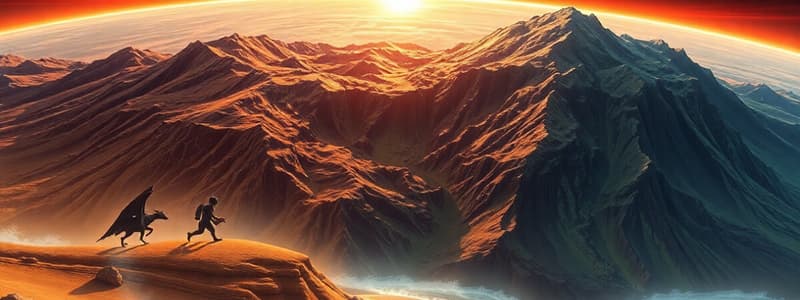Podcast
Questions and Answers
What is the estimated age of the Universe?
What is the estimated age of the Universe?
- 2.0 billion years
- 1.2 billion years
- 3.5 billion years
- 4.6 billion years (correct)
Which of the following is NOT considered a characteristic of life?
Which of the following is NOT considered a characteristic of life?
- They move independently (correct)
- They are made up of cells
- They grow and develop
- Capable of production
What is the term used for organisms that can produce their own food?
What is the term used for organisms that can produce their own food?
Autotrophs
Which of these is NOT a type of asexual reproduction?
Which of these is NOT a type of asexual reproduction?
The term "homeostasis" refers to the process of maintaining a stable internal environment within an organism.
The term "homeostasis" refers to the process of maintaining a stable internal environment within an organism.
What is the primary function of the Muscular System?
What is the primary function of the Muscular System?
Which line of defense in the immune system involves lymphocytes and antibodies?
Which line of defense in the immune system involves lymphocytes and antibodies?
What is the earliest known time period in the evolution of life on Earth, as mentioned in the text?
What is the earliest known time period in the evolution of life on Earth, as mentioned in the text?
What type of organism is believed to have been the first photosynthetic organism on Earth?
What type of organism is believed to have been the first photosynthetic organism on Earth?
The Mesozoic era was dominated by mammals.
The Mesozoic era was dominated by mammals.
Name the era that constitutes the most recent lifeforms and paleontological evidence.
Name the era that constitutes the most recent lifeforms and paleontological evidence.
Which of the following is considered a unifying theme in the study of life?
Which of the following is considered a unifying theme in the study of life?
What is the basic unit of life?
What is the basic unit of life?
What is the basic unit of heredity and variation in an organism?
What is the basic unit of heredity and variation in an organism?
What system in the body plays a crucial role in fighting off invading microorganisms and diseases?
What system in the body plays a crucial role in fighting off invading microorganisms and diseases?
What is the term for the basic unit of a line?
What is the term for the basic unit of a line?
A ________ cell or organism possesses a clearly defined nucleus.
A ________ cell or organism possesses a clearly defined nucleus.
What is the term for a thread-like structure that carries genetic information?
What is the term for a thread-like structure that carries genetic information?
What is the term for the process of creating a new organism by combining two genes from different parents?
What is the term for the process of creating a new organism by combining two genes from different parents?
What system in the body is responsible for regulating body temperature?
What system in the body is responsible for regulating body temperature?
Flashcards
Prokaryote
Prokaryote
Single-celled organism lacking a nucleus. Examples include bacteria.
Eukaryote
Eukaryote
Organism with cells containing a nucleus and other membrane-bound organelles.
Stromatolites
Stromatolites
Sedimentary rock formations where early prokaryotic life was discovered.
Cellular Respiration
Cellular Respiration
Signup and view all the flashcards
Cyanobacteria
Cyanobacteria
Signup and view all the flashcards
First eukaryotes
First eukaryotes
Signup and view all the flashcards
Paleozoic Era
Paleozoic Era
Signup and view all the flashcards
Mesozoic Era
Mesozoic Era
Signup and view all the flashcards
Cenozoic Era
Cenozoic Era
Signup and view all the flashcards
Characteristics of Life
Characteristics of Life
Signup and view all the flashcards
Growth
Growth
Signup and view all the flashcards
Development
Development
Signup and view all the flashcards
Metabolism
Metabolism
Signup and view all the flashcards
Homeostasis
Homeostasis
Signup and view all the flashcards
Reproduction
Reproduction
Signup and view all the flashcards
Asexual Reproduction
Asexual Reproduction
Signup and view all the flashcards
Sexual Reproduction
Sexual Reproduction
Signup and view all the flashcards
Evolution
Evolution
Signup and view all the flashcards
Adaptation
Adaptation
Signup and view all the flashcards
Ecosystem
Ecosystem
Signup and view all the flashcards
Binary Fission
Binary Fission
Signup and view all the flashcards
Photosynthesis
Photosynthesis
Signup and view all the flashcards
Fossil
Fossil
Signup and view all the flashcards
Zircon Crystal
Zircon Crystal
Signup and view all the flashcards
Eukaryotes vs. Prokaryotes
Eukaryotes vs. Prokaryotes
Signup and view all the flashcards
Divine Creation
Divine Creation
Signup and view all the flashcards
Extraterrestrial Origin
Extraterrestrial Origin
Signup and view all the flashcards
Origin from Non-Living Matter
Origin from Non-Living Matter
Signup and view all the flashcards
Alexander Oparin
Alexander Oparin
Signup and view all the flashcards
Life Science
Life Science
Signup and view all the flashcards
Bioscience
Bioscience
Signup and view all the flashcards
Zoology
Zoology
Signup and view all the flashcards
Botany
Botany
Signup and view all the flashcards
Microbiology
Microbiology
Signup and view all the flashcards
Cell
Cell
Signup and view all the flashcards
Response to Environment
Response to Environment
Signup and view all the flashcards
Body System
Body System
Signup and view all the flashcards
Organ System
Organ System
Signup and view all the flashcards
Ecology
Ecology
Signup and view all the flashcards
Autotrophs
Autotrophs
Signup and view all the flashcards
Heterotrophs
Heterotrophs
Signup and view all the flashcards
Anatomy
Anatomy
Signup and view all the flashcards
Physiology
Physiology
Signup and view all the flashcards
Study Notes
Evolving Concept of Life
- Earth formed 4.6-3.8 billion years ago (BYA), experiencing violent meteorites and volcanic eruptions. Zircon crystals formed during this period.
- Life on Earth initially appeared 3.5 BYA, beginning with prokaryotes. Stromatolites, sedimentary rock formations, are where these were discovered.
- Photosynthetic organisms, cyanobacteria (blue-green algae), thrived 3 BYA.
- Eukaryotes, more complex organisms, appeared 2 BYA, and multicellular organisms evolved 1.2 billion years ago.
- The Paleozoic era (500 MYA) saw trilobites and cephalopods dominate the oceans, particularly during Cambrian and Ordovician periods.
- The Mesozoic era (251-65.5 MYA), the age of reptiles, included Triassic, Jurassic, and Cretaceous periods.
- The Cenozoic era (250 TYA) is the recent era, with the evolution of Homo erectus.
- The universe is approximately 4.6 billion years old.
- Prokaryotes are the common ancestor of all life.
- Eukaryotes have a true nucleus.
Growth and Development
- Growth is the appearance and measurable development of living organisms.
- Divine creation suggests some divine power as the source for life on earth.
- Extraterrestrial origin and non-living to living matter are aspects of the question of how life began on Earth.
Evidences for Life's Origin
- Fossils provide evidence of life forms through time.
- Rock layers and geological events (volcanic eruptions, earthquakes, and erosion) offer clues about the history of the Earth.
- Life science is composed of various disciplines, including theories explaining the structure and function of living things.
- Bioscience is the study of living things, encompassing biology.
Characteristics of Life
- Organisms are made up of cells.
- Growth and development are characteristic of life.
- Metabolism (energy processes) is vital for life functions.
- Organisms are responsive to their environment.
- Homeostasis is the maintenance of internal balance.
Types of Organisms
- Eukaryotes possess a defined nucleus.
Additional Notes (from the second page)
- Biology and Society: Biological science influences society.
- Unifying Themes in Biology: Interrelated aspects such as biological systems, cell structure, interactions with the environment, energy, form and function, reproduction/inheritance, regulation, adaptation and evolution are studied.
- Cell as basic unit of life: The cell is the smallest unit of life.
- Perpetuation of Life: Asexual (single-parent) and sexual (double-parent) reproduction processes sustain life. Methods include fragmentation, binary fission and budding.
- Important Organ Systems and their functions
- Muscular system: movement and posture.
- Circulatory System: blood circulation
- Digestive System: food breakdown
- Respiratory System: gas exchange
- Endocrine System: hormone control
- Immune System: body defense
- Nervous System: control and coordination.
Additional Notes (from the third page)
- Characteristics of Life (continued): form and function, reproduction, heredity, homeostasis, adaptation and evolution are discussed.
- Molecular Biology: DNA, genes, genotype, and phenotype are discussed.
- Engineering Techniques: Selection breeding, hybridization, inbreeding, cloning and Gene Splicing/Gel Electrophoresis/Recombinant DNA technology.
- Organ Systems: A variety of systems are discussed.
Additional Notes (from the fourth page)
- Organ Systems (continued): The Integumentary, Urinary, Lymphatic, and Reproductive systems are discussed.
- Defense Mechanisms: Physical and Chemical barriers, and Immune cells are mentioned.
- Macrophages and Antigen Presenting Cells: Immune responses and phagocytic cells discussed.
Studying That Suits You
Use AI to generate personalized quizzes and flashcards to suit your learning preferences.




